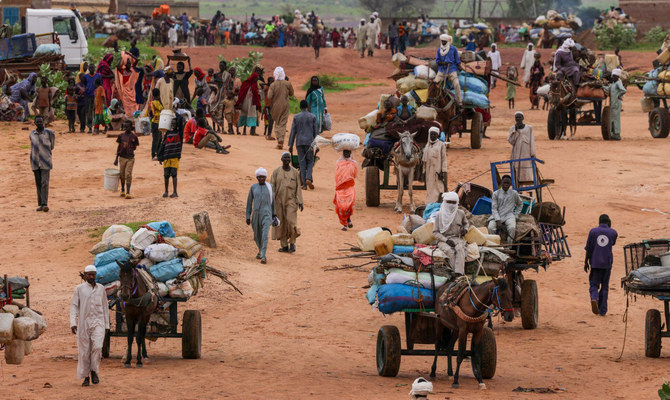Mukesh Kapila
When did Sudan’s civil war start? This is a surprisingly difficult question to answer, with the most common response being April 2023. But that was just the start of the current phase, triggered by a falling out between Gen. Abdel Fattah Al-Burhan and Mohammed Hamdan Dagalo, commonly known as Hemedti, the commanders of the Sudanese Armed Forces and rival militia the Rapid Support Forces respectively.
In reality, there has been little peace in the country since independence in 1956. Its first civil war raged from 1955 to 1972 and a second followed between 1983 and 2005, punctuated by the Darfur genocide in 2003-2004. South Sudan broke away in 2011 and conflicts rumbled on in the Nuba Mountains and Blue Nile.
Several factors lie behind the turmoil: ethnic, ideological, and religious differences; grievances around representation in governance; greed over possession of the nation’s immense natural wealth; and the geopolitical interests of outsiders.
Along the way, any brief experimentation with civilian democracy was extinguished by military regimes.
The question of when Sudan’s strife will finally end is easier to answer: not yet, and not for some time. The country’s power brokers and their external sponsors are not ready to make peace as no side has achieved ascendance in the existentialist struggle between the belligerents.
Also consider history’s iron rule: The past must be squared away before a better future can be built. We can learn that from the Palestine-Israel conflict, even if peacemakers in Sudan do not. Attempting to brush aside the harm and hurt of the past, especially the Darfur genocide, without ensuring accountability, justice and restitution simply means repeating Sudan’s toxic history. Nevertheless, history also offers the consolation that all wars do eventually end. And experience teaches us that the spirit of humanity is eventually required to bridge the divide between war and peace. Preventing that precarious passage from being completely ruptured is the role of humanitarian provision.
This is important in Sudan. Not only out of pity for the desperate, suffering people of the country. Nor as a cynical calculation that assistance now will reduce the burden on the international purse of future recovery.
More importantly, humanitarianism is about reaching the place where wars begin: the minds of men. The Sudanese people are deeply traumatized, whether as victims of terrible and degrading atrocities or as the perpetrators who inflict them on others without compunction. Brutalized psyches cannot be expected to think peacefully. But could paranoid minds be opened by humanitarian solidarity?
All else having failed, this is certainly worth trying. But we are not doing very well on the humanitarian front. Among Sudan’s population of 49 million, 25 million people need assistance, 6 million are internally displaced and 1.5 million are new refugees.
This is the biggest national humanitarian caseload in the world. And other records for misery and deprivation continue to be set. Nearly 40 percent of the population are seriously food insecure, including 3.5 million children who are suffering from acute malnutrition. Ninety percent of Sudanese children get little or no schooling. Two-thirds of the population lack access to healthcare, and 80 percent of hospitals in conflict areas are non-functional. Outbreaks of disease, including malaria, measles, dengue and cholera, continue, and there is a resurgence of desert locusts.
The economy has shrunk by 12 percent since the start of the war and gross domestic product is expected to fall by 18 percent this year. In comparison, the decline in Syria over the course of its long civil crisis has averaged 5 percent annually.
A UN humanitarian appeal seeks $2.7 billion in lifesaving aid for Sudan this year, compared with $2.57 billion last year. However, only 42 percent of that 2023 UN target, which aimed to help 18.1 million people, was funded. This year the outcome is likely to be similar, though the targeted population is smaller, at 14.7 million. This suggests that this year’s appeal is designed to help fewer people but overall needs have grown.
In any case, these UN numbers are somewhat moot as the organization’s own reports reveal it managed to reach only 5.7 million people in 2023 — a third of its target. Even that number is disputed and rejected by some as an overestimation, with some independent surveys indicating that less than 16 percent of the population received aid. This means Sudan is unique in having the largest number of people in need of help and the smallest number receiving assistance.
Even accepting the UN figures at face value, the reduced numbers of accessed beneficiaries should have been well catered-for with the relatively greater proportion of the appeal funded. But we do not know the true aid impact and especially what happened to the two-thirds of the target population not reached. Did they perish? That is unlikely according to mortality statistics.
That being the case, how did these non-recipients of UN aid manage to help themselves, or who helped them? The contribution of the Sudanese diaspora and local aid networks, including front-line “emergency response rooms” created by “resistance committees,” is critical but not quantified, and UN coordination mechanisms do not include them.
There is also the continuing question about the current shortfall between the number of people assessed as being in need and the smaller number targeted by the official UN appeal. That gap currently stands at 10 million, an increase from 6 million last year. Who is responsible for serving the needs of these people? Probably the International Red Cross and Red Crescent Movement and other agencies that are not part of the official UN appeal. But we do not know for sure because data is not comparable, openly shared or verifiable. This also means the comparative efficiency of agencies cannot be assessed.
The UN appeal works with 165 partner agencies but their in-country presence and reach are unclear. It would be unethical if Sudan’s agony was serving as a fundraising opportunity for organizations that are unable themselves to deliver aid on the ground but extract a proportion of donations as fees or overheads simply for acting as intermediaries for the groups that are actively providing assistance.
Such “rent-seeking” practices add to inefficiencies in the delivery process at a time when resources are severely constrained and the moral imperative is to use every available dollar to help ease suffering.
However, the difficulties of delivering aid inside Sudan cannot be underestimated. Red tape delays imports at Port Sudan. Aid convoys are harassed at checkpoints, including through the solicitation of bribes, the looting of warehouses, fraud and corruption. The fierce fighting causes unpredictable delays. International humanitarian law is violated with impunity.
The courage and commitment of the humanitarian aid workers is not in dispute. Fifty-four of them were killed, wounded or kidnapped in 2023, a five-fold increase from the year before. But the hasty exit from the country by international workers transferred the risks to local staff who do not receive the same protection and benefits.
As suggested previously, humanitarians could potentially help build a movement toward peace in Sudan but only by tackling their own dysfunctions first. The first step is to regain stakeholder trust. Perhaps we need some sort of “blue tick” system for international and local bodies that verifies and certifies credibility.
Secondly, there must be greater transparency within the humanitarian sector through the sharing of consistent and verified statistics. Aid agencies alone cannot be the judges of needs, the jury that grades their own work, and the ones responsible for executing the delivery of aid. There are obvious conflicts of interest there that could perhaps be resolved through the introduction of independent accountability mechanisms.
Thirdly, with international organizations constrained from working in Sudan, localization of aid must be vigorously promoted as a way to develop context-specific solutions, generate greater value for money and, ultimately, increased outreach.
Fourthly, if negotiators cannot help end the fighting, let them expend more of their diplomatic capital on the issues of humanitarian access and challenges in protecting aid workers. This could build confidence and perhaps provide a path toward real peace.
To be fair, the problems of providing humanitarian aid in Sudan are not unique. They reflect a global aid system that is over-burdened with many crises. Given its complexities, Sudan perhaps is not the most obvious place to try to instigate difficult reforms that challenge entrenched practices. But a crisis is also an opportunity for change, especially when the survival of the suffering millions is as existential a struggle as the war is for the belligerents.
Although it would be good to be proved wrong, 2024 is unlikely to be the year that brings peace in Sudan. But neither must we allow it to be the year the world failed, yet again, to perform better in the name of humanity.







